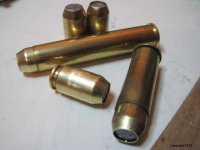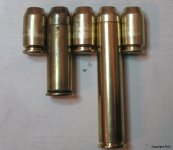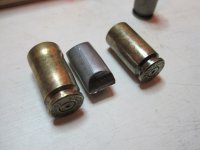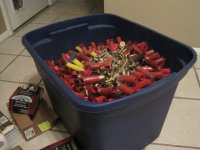We have results.
I am very impressed with how tough this bullet is, and how well they hold together.
If you're still in kindergarten, just look at the pictures. You won't hurt my feelings, by skipping the text. ...I probably would, too. This is going to be a long thread.
To break up the monotony a bit, I'll be using
bold letters to set some words off.
We fired 10 bullets of 3 different weights from a Ruger Super Blackhawk and a S&W 29 (both in .
44 Mag, of course), at about 950 fps (estimated).
The only factory ammo we remembered to take with us for comparison was some Remington 240 grain Hollow Points at 1180 fps. Since we forgot to fire any other revolver rounds into the wet pack, it wasn't quite as useful as we had hoped. {slap forehead}
We also fired 20 of the 275 grain bullets from an H&R Handi-Rifle in
.444 Marlin, from 1900 to 2400 fps (estimated). The ammunition chosen for comparison was Hornady Superformance 265 gr FP Interlocks, at 2400 fps.
There were 3 different
types of bullets tested:
1.
Plain - The case is not annealed, and the core is not bonded.
2.
Annealed - The cases is annealed before the core is seated.
3.
Bonded - The cores were bonded to the jackets.
There were 3 different
weights tested:
1.
275 grain - This was the only weight tested in the .444, and only 2 bullets of this weight were tested in the .44 Mags.
2.
225 grain - This was the primary weight for the revolvers. None of these were tested in the .444.
3.
185 grain - This was a developmental failure at the bench (equipment limitation), only two were fired, only in the .44 Mags... for the heck of it.
Most of the bullets were fired into a crappy cooler that was packed as tight as I could get it, with wet phone books, magazines, catalogs, and newspaper. A few bullets were fired into targets of opportunity. That will be pointed out, as needed.
To "calibrate" my test media, I fired a
.177" BB at 625 fps. It penetrated 1/8". At that velocity, standard ballistic gel penetration is just over 3". (I would insert the "GASP" smiley, but the forum won't let me.)
A Remington
.22 LR Golden Bullet from a 22" bbl penetrated only 5/8". ("GASP" again.) That stuff was packed
tight.
As much paper as possible was removed from the bullets before being weighed.
Look at those mushrooms on top! They're better than most commercial bullets I've recovered.
The key to the photograph:
- 275 gr Bonded, .444 Marlin, est. muzzle velocity of 2225 fps, expanded to 0.931", cleaned weight of 177 gr. Penetrated 8.5".
- 275 gr Bonded, .444 Marlin, est. muzzle velocity of 2300 fps, expanded to 0.704", cleaned weight of 184 gr. Penetrated 9".
- 275 gr Bonded, .444 Marlin, est. muzzle velocity of 2360 fps, expanded to 0.741", cleaned weight of 178 gr. Penetrated 10".
- 275 gr Bonded, .444 Marlin, est. muzzle velocity of 2400 fps, expanded to 0.931", cleaned weight of 140 gr. Penetrated 10".
- 275 gr Plain, .444 Marlin, est. muzzle velocity of 2000 fps, expanded to 0.990", cleaned weight of 244 gr. Penetrated 9". (This bullet carried the piece of plastic more than 7" through the wet-pack, before it ripped off; and was also the first bullet tested. It was fully expanded by passing though a gallon jug {6"} of water, before hitting the cooler.)
- 265 gr Hornady Interlock FP, .444 Marlin, factory advertised muzzle velocity of 2400 fps, expanded to 1.053", cleaned weight of 207 gr. Penetrated 7".
- 240 gr Remington Hollow Point, .44 Rem Mag, factory advertised muzzle velocity of 1180 fps, expanded to 0.998" (core), cleaned weight of 235 gr. Penetrated N/A. (This bullet penetrated about 2" of the wet-pack before veering wildly off course, exiting the interior of the bottom of the cooler, and travelling through about 14" of styrofoam insulation, then coming to a stop. However... in that 2" of wet-pack, it managed to lose its jacket {which expanded to .735", and weighed 38 gr}. Altogether the best recovered weight of the bullets that expanded, but pretty sub-par performance, even for a revolver.)
- 275 gr Bonded, .444 Marlin, est. muzzle velocity of 2000 fps, expanded to 0.806", cleaned weight of 161 gr. Penetrated 24+". (This bullet penetrated a weaker part of the cylinder head, went through 14+ inches of a wet juniper stump, and plowed another 12" inches of dirt. One tough SOB...)
- 275 gr Bonded, .444 Marlin, est. muzzle velocity of 2000 fps, expanded to a doughnut, cleaned weight of 34 gr. Penetrated 0". (This bullet hit a very thick portion of a cast iron cylinder head. The cylinder head has survived pummeling by some really heavy hitters, so I don't blame the bullet, at all. The results are interesting to look at. So, I included it here. The next post has a close up.)
- 225 gr Plain, .44 Rem Mag, est. muzzle velocity of 950 fps, expanded to 0.554", cleaned weight of 211 gr. Penetrated about 6". (Fired into sloppy mud with gravel and sand.)
- 225 gr Annealed, .44 Rem Mag, est. muzzle velocity of 950 fps, expanded to 0.430", cleaned weight of 225 gr. Penetrated about 5". (Fired into wet pack.)
- 185 gr Plain, .44 Rem Mag, est. muzzle velocity of 950 fps, expanded to 0.434", cleaned weight of 183 gr. Penetrated about 6". (Fired into clay.)
- 225 gr Plain, .44 Rem Mag, est. muzzle velocity of 950 fps, expanded to 0.464", cleaned weight of 221 gr. Penetrated about 6". (Fired into sloppy mud with gravel and sand.)
There were also several 275 gr Bonded, Plain, and Annealed bullets fired into mud and dirt with the .444 Marlin, that
could not be recovered. They simply penetrated too deeply to be dug out. (Another smiley should be here.)
Another view.
Flipped over.
Another view, flipped over.
Close-ups of the 4 bonded bullets fired at the highest muzzle velocities:
Note the missing primer. It blew it out,
backwards, when the bullet impacted the wet-pack.
The forum software is getting angry at me. I'll cover a few of the details in the next post.


 )
)







